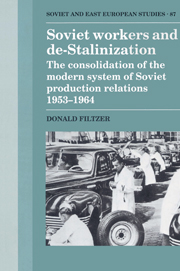 Soviet Workers and De-Stalinization
Soviet Workers and De-Stalinization Book contents
- Frontmatter
- Contents
- List of tables
- Preface and acknowledgements
- List of terms and abbreviations
- Introduction: the contradictions of-Stalinization
- Part I Labour policy under Khrushchev: issues and results
- 1 The worker and the work environment
- 2 The reform of labour legislation and the re-emergence of the labour market
- 3 The labour shortage
- 4 The wage reform
- Part II De-Stalinization and the Soviet labour process
- Conclusion
- Notes
- Bibliography
- Index of industrial, mining, and construction enterprises
- General index
- Soviet and East European Studies
1 - The worker and the work environment
Published online by Cambridge University Press: 29 January 2010
- Frontmatter
- Contents
- List of tables
- Preface and acknowledgements
- List of terms and abbreviations
- Introduction: the contradictions of-Stalinization
- Part I Labour policy under Khrushchev: issues and results
- 1 The worker and the work environment
- 2 The reform of labour legislation and the re-emergence of the labour market
- 3 The labour shortage
- 4 The wage reform
- Part II De-Stalinization and the Soviet labour process
- Conclusion
- Notes
- Bibliography
- Index of industrial, mining, and construction enterprises
- General index
- Soviet and East European Studies
Summary
The industrial structure created by Stalinist industrialization was quite specific to the Soviet Union as a social formation. The elite attempted to exercise control through the extreme centralization of decisionmaking, enforced through five-year, annual, and quarterly plans. Because of the bureaucratic, authoritarian nature of the system, this over centralization in fact gave rise to its virtual opposite, as individual managers and workers tried to cope the best they could with conditions that were often outside their control. Coordination and predictability, which must form the basis of planning, constantly eluded both planners and executors of the plan, as they struggled to cope with uncertainties and shortages, and in so doing reproduced these same disruptions elsewhere in the cycle of production and distribution.
For reasons that will be elaborated in more detail in Part II, the enterprise confronted both workers and managers as an alien, ‘objective’ environment through which they had constantly to wend their way, circumventing official regulations and prescriptions and nominal plans in order to achieve the production indicators that would secure workers their earnings and managers their bonuses and upward mobility within the political system. First, there was the planning system itself, which was bureaucratically top-heavy and thus divorced from the vital information that planners required to construct workable plans and instructions. The system was fiercely competitive: ministries jockeyed with one another for preferential investment allocations; enterprises within ministries did the same. Because the centre had no effective means of controlling how plans were actually implemented, the plans were constantly distorted at enterprise level.
Information
- Type
- Chapter
- Information
- Soviet Workers and De-StalinizationThe Consolidation of the Modern System of Soviet Production Relations 1953–1964, pp. 13 - 34Publisher: Cambridge University PressPrint publication year: 1992